



Albumen Quality of Table Eggs
In the Canadian Poultry Council's Tech Info 14, Dr John Summers describes some experiments investigating factors to prevent overly runny egg whites, a cause of occasional complaints from fast-food outlets.The Problem
In recent years there have been complaints, especially from fast food outlets, about the interior quality of eggs. A small percentage of the eggs they receive have a very runny, thin albumen which quickly spreads across the cooking surface upon breaking out of the egg. Such eggs not only interfere with methods of food preparation, but give the impression of a poor quality product and increase potential for customer complaints.
In extreme cases, the area of the thin albumen would be in excess of twice that which is considered normal. Since the thick albumen is not affected, such eggs would be classified as Grade A, since the criteria for measuring albumen quality is the height of the thick albumen.
Albumen Quality
Considering egg albumen, the length of storage as well as environmental conditions of storage can significantly reduce quality. Factors such as incorrect temperature and humidity increase the loss of carbon dioxide (CO2) from the egg which is compounded by the length of storage. The result is a breakdown in albumen structure, with the net result being an egg with albumen that spreads thinly when broken out on a cooking surface rather than remaining firm and gelatinous as a fresh egg should. The effect of temperature and length of storage on albumen height are demonstrated in Table 1.
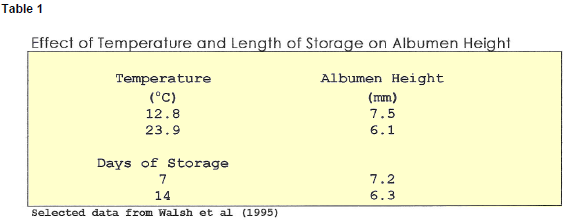
Diet Protein Level
The level of dietary protein and/or amino acids, as well as the acid-base balance of the diet are nutritional factors that might be considered to affect albumen quality. To test the diet protein and/or adequacy of essential amino acid effect, 4 dietary protein levels (14, 16, 18, and 20%), in diets containing 2850 kcal of ME/kg diet were fed. Such diets would range from what is considered suboptimal to excessive levels of protein according to industry standards.
Experiment 1
Each diet treatment was fed to 8 replicates of 4 individual, caged, White Leghorn type pullets. The experiment was initiated when the pullets were 17 weeks of age and bird performance was measured through 12, 28 day periods. Eggs laid on the last 2 days of each period were used to measure egg shell and albumen quality. As a measure of albumen quality, height of the thick albumen was measured and the degree of the spread of the thin albumen determined 30 seconds after the egg was broken out. The thin albumen was estimated by a tracing made under a glass surface on which the egg was broken out and converting this to a measure of surface area.
Measurements were take at periods 2, 4, 6, 8, 10, and 12. However, since there were few meaningful differences of biological significance noted for the various levels of dietary protein the results for diets are shown as averages for periods 2 through 10. The individual diet differences are shown for the 12th period, when it would be expected that differences, if present, would be more likely to be experienced (Table 2).
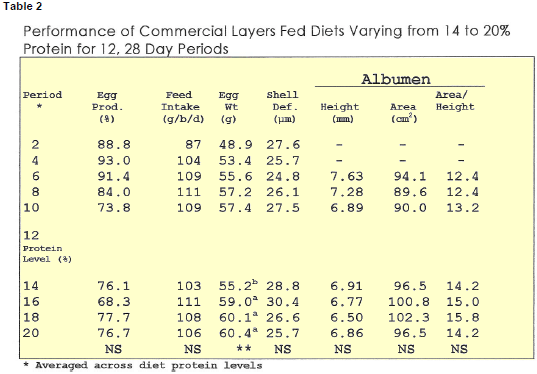
Results
Most of the production parameters measured, were as to be expected, from similar reported treatments. Albumen height declined with age (periods 6 through 10) but was not affected by the diet protein level (period 12). There was also no suggestion that albumen area was altered with age of bird or level of dietary protein. However, the increased ratios for albumen area over height (period 12 vs. 6, 8, and 10), is the result of a lower quality egg as the hens aged.
Vanadium and Egg Quality
When considering nutritional factors affecting internal egg quality, the only effect which has been repeatedly noted has been that of the mineral vanadium. Vanadium present in a laying diet is usually the result of its presence in certain samples of rock phosphate used as a source of dietary phosphorus. Eyal and Moran (1984) fed 20 and 30 ppm of supplemental vanadium to laying hens during a 4 week trial (Table 3). Little or no significant differences were noted for percent production or egg size. However, Haugh units and albumen height were significantly reduced with vanadium supplementation. The proportion of outer thin increased at the expense of the inner thin albumen.
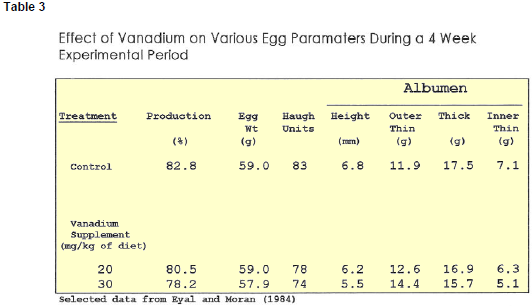
Benabdeljelil and Jensen (1990) investigated the ability of ascorbic acid and chromium to counteract the deleterious affect of vanadium. Ascorbic acid at a level of 100 ppm, overcame the reduced Haugh unit score noted with 10ppm of supplemental vanadium (Table 4). However, chromium supplementation was not effective in countering the negative effect of vanadium on egg quality.

Experiment 2
Acid-Base Balance
Another possible factor influencing albumen quality could be dietary electrolyte balance. Unlike most other animals producing a product, like meat, milk or fetus, where a constant uniform supply of nutrients is required throughout the day, the hen first lays down approximately 6 grams of protein in an egg in 4 to 5 hours and then approximately the same amount of calcium carbonate (ie: the shell) during the next 18 to 20 hours. Thus the possibility of dietary electrolyte balance influencing acid-base balance in the body is a reasonable consideration.
Thus in a further experiment, Leeson and Newman studied the effectiveness of altered dietary electrolyte balance on egg quality. White Leghorn type pullets of the same age and similarly housed as in Experiment 1, were fed corn, soya, 20% wheat diets, supplemented with calcium chloride and sodium bicarbonate, which produced diets with levels of electrolytes or acid-base balance of 150,200 and 300 m eq/kg, according to the following equation (Na+K-Cl). Bird performance and egg quality measurements were carried out similar to those described in the previous experiment.
Results
The results of the trial are shown in Table 5. Since there were no significant differences noted with increased diet electrolyte balance, the data have been averaged across diet m eq for periods 2 through 10 and the individual treatment values shown for period 12 only. There was no indication that dietary electrolyte balance had an influence on albumen quality.
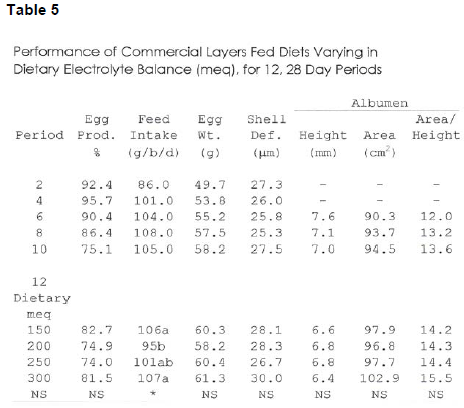
Individual Bird Data
The researchers then looked at some of the individual bird results of the above two trials. In Table 6, is shown data from 4 birds from each trial, two classified as having compact albumen and two as spreading albumen, from period 6. As can be noted there is a marked difference in albumen area with the two types of birds. Such results suggest significant bird differences with respect to the “runny egg white” trait.

Health Status
Since no dietary effects on albumen quality were noted with the first two experiments, 10 birds were selected from the second experiment with the best albumen quality, and 10 with the poorest albumen quality. Since Infectious Bronchitis is a disease condition most likely to affect albumen quality, the 20 birds were blood sampled and ELISA titers for IBV determined. Although there were considerable bird to bird variations, the mean titer value for the two groups of birds was similar and their profiles were such as to indicate no IBV challenge.
Genetic Difference
In order to investigate whether the marked individual bird variation noted for “runny egg white” could be explained by genetic make up of the hens, the 20 birds selected were inseminated with semen from one unrelated White Leghorn cockerel. Eggs were collected for a 10 day period and then pedigree hatched, where chicks can be related back to individual hens. The pullets from these pedigree hatches were grown to maturity and their eggs examined for albumen quality. The results presented in Table 7 suggest there is a genetic influence on albumen quality as pullets from mothers with good or compact albumen characteristics produced eggs with lower thin white area than did pullets from mothers that produced eggs with spreading albumen characteristics.
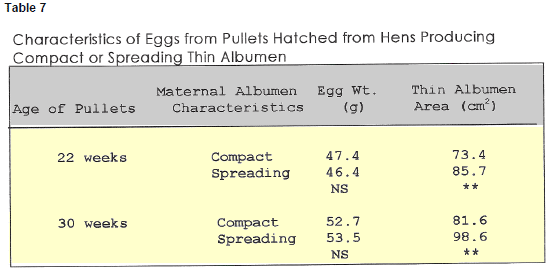
Conclusions
It is concluded that a proportion of hens in a flock consistently produce eggs with thin albumen that spreads quickly when eggs are broken out. The problem does not appear to be related to nutrition or the health status of the flock. It would appear that a genetic component is involved which presents a challenge for breeders to select against this trait.
References
Benabdeljelil, K. and L. S. Jensen, 1990. Effectiveness of Ascorbic Acid and Chromium in Counteracting the Negative Effects of Dietary Vanadium on Interior Egg Quality. Poultry Science 69: 781-786
Eyal, A. and E.T. Moran Jr., 1984. Egg changes Associated with Reduced Interior quality Because of Dietary Vanadium Toxicity in the hen. Poultry Science 63: 1378-1385
Walsh, T. J., R.E. Rizk and J. Broke, 1995. Effects of Temperature and Carbon Dioxide on Albumen Characteristics, Weight Loss and Early Embryonic Mortality of Long Stored Hatching Eggs. Poultry Science 74: 1403-1410








